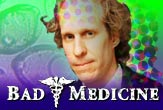Discovery of 'Red Gene' Points to Bad Apples

Australian scientists have identified the gene that controls the color of apple skins, an advance that could lead to brighter and more attractive fruit. Sounds tempting, but you might remember what happen the first time humans fell for a shiny apple.
The best outcome from this discovery would be that consumers, so allured by the genetically modified creation, eat more apples. Apples are cheap and nutritious, a wonderful alternative to a midday trip to the vending machine for junk food.
But the gene that makes apples red makes agribusiness see green.
If history is our guide, food producers will turn the perfect snack food into a cosmetically appealing yet tasteless product. The biggest growers would be the first to benefit from controlling apple color to make their apples more visually appealing to consumers than their cash-strapped, smaller competitors' apples. They can scrimp on taste and focus on appearance, mass-production and global shipping.
Science with a bite
On the surface, this seems like a great discovery, the result of clever scientific detective work. Apple growers have long known that sunlight affects an apple's color. Apples that are naturally red upon maturity won't turn red if grown in the shade. This implies that sunlight activates the master gene responsible for color.
The Aussie scientists covered apples on a tree with dark bags to block sunlight to see what would happen. Once the apples matured, the scientists—led by the aptly named Adam, as in Adam Takos of CSIRO, the Commonwealth Scientific and Industrial Research Organization—exposed the apples to sunlight and monitored the production of anthocyanins, natural compounds responsible for the dark colors in many flowers and fruits.
Sign up for the Live Science daily newsletter now
Get the world’s most fascinating discoveries delivered straight to your inbox.
In this controlled setting, they could determine that a gene named MdMYB1 was rapidly promoting anthocyanin synthesis in the apple skin as soon as the sunlight hit it. The results appear in the November issue of the journal Plant Physiology.
Of seeds and consequences
"Color is a very important part of fruit marketing," said Mandy Walker of CSIRO in a press release about the gene discovery. "If fruit doesn't look good, consumers are far less likely to buy it, no matter how good it might taste."
Ah, yes. Now we're getting to the core of this work.
"Looking good" is what drove the development of the Red Delicious, the best-selling and worst-tasting apple in America. While it might have started tasty a century ago, farmers—driven by consumer demands for bright red apples, and by supermarket demands for a consistently shaped fruit with a long shelf life—concentrated on appearance and have bred an apple that looks great but no longer tastes good.
This is the face of agribusiness. Just over 100 years ago, there were more than a thousand apple varieties available in the United States and Canada of varying colors, shapes and sizes, some even with stripes. This has dwindled to less than a hundred varieties, and the vast majority of apples harvested are Red Delicious, Golden Delicious and Granny Smith, according to the U.S. Apple Association. These are the most easily mass-produced.
Yet the Red Delicious, once untouchable and comprising 75 percent of the Washington state crop in the 1980s, is now down to 37 percent of the state harvest. Could it be that consumers finally are catching on that the name is only half right?
Genetic diversity
If you're bored of the big three, which merely meet the marketing demand for a red, green and yellow in the supermarket bins, consider visiting a farmers' market. Although harvested a month or two ago, local apples are still crisp and full of flavor. Farmers can keep apples fresh easily up to six months in cold, low-humidity storage units, removing just what they need to sell week by week. My local market sells ten kinds of apples.
By supporting local farms and frequenting farmers' markets, you will learn what fruits and vegetables are supposed to look like and will understand their true beauty. You just might be disgusted by the waxy, bright food in a supermarket.
It's time to get back to the garden.
Christopher Wanjek is the author of the books “Bad Medicine” and “Food At Work.” Got a question about Bad Medicine? Email Wanjek. If it’s really bad, he just might answer it in a future column. Bad Medicine appears each Tuesday on LIveScience.
- Top 10: Good Foods Gone Bad
- Top 10 Bad Things That Are Good For You
- 10 Easy Paths to Self Destruction

Christopher Wanjek is a Live Science contributor and a health and science writer. He is the author of three science books: Spacefarers (2020), Food at Work (2005) and Bad Medicine (2003). His "Food at Work" book and project, concerning workers' health, safety and productivity, was commissioned by the U.N.'s International Labor Organization. For Live Science, Christopher covers public health, nutrition and biology, and he has written extensively for The Washington Post and Sky & Telescope among others, as well as for the NASA Goddard Space Flight Center, where he was a senior writer. Christopher holds a Master of Health degree from Harvard School of Public Health and a degree in journalism from Temple University.









